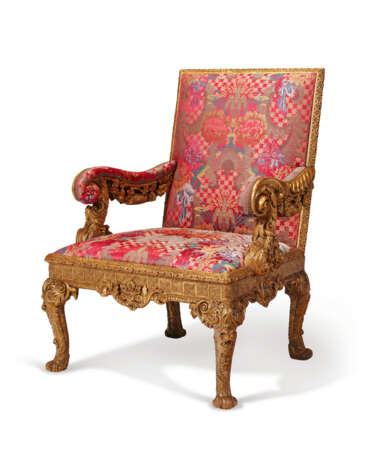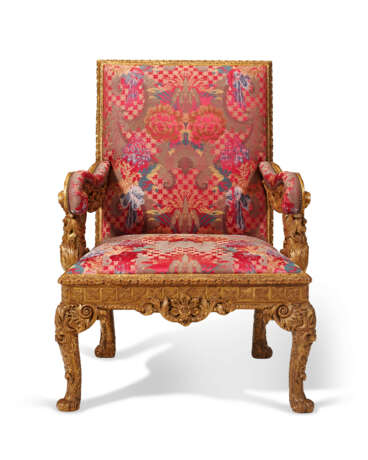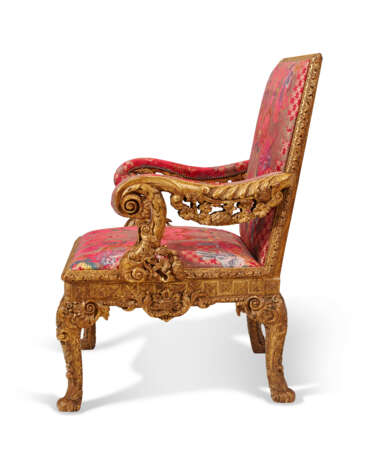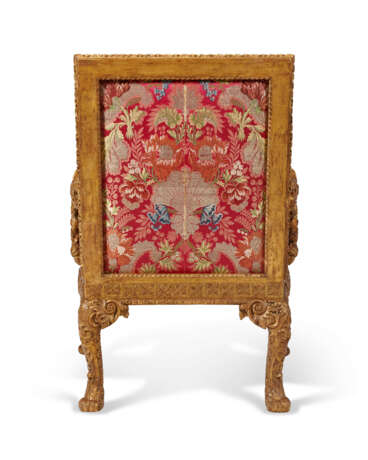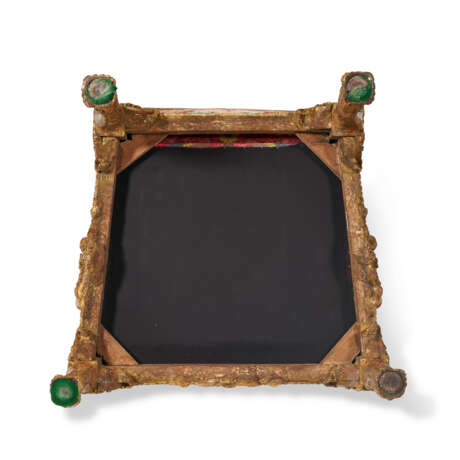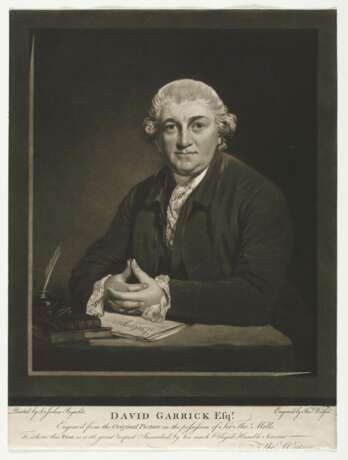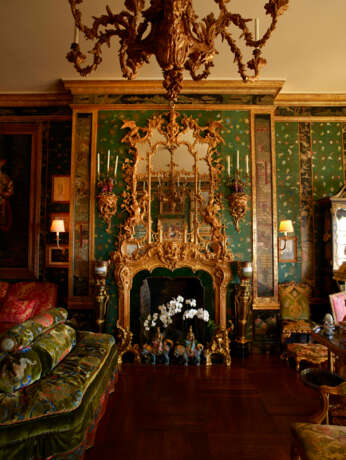ID 819952
Lot 375 | A GEORGE II GILTWOOD ARMCHAIR
Estimate value
$ 50 000 – 80 000
CIRCA 1740, ALTERED
With flower filled guilloche-carved frame, the rectangular back, down-scrolled arms and drop-in seat covered in crimson silk brocaded with polychrome flowers, bows and metallic thread swags, possibly French, mid-18th century, the reverse in a complimentary silk, French, 18th century, the gadrooned arms suspending floral garlands and on acanthus-wrapped supports, the rails with flower-filled Greek key borders centered by pierced floral cartouches flanked by acanthus leaves, over foliate-headed scaled cabriole legs terminating in leaf-wrapped inscrolled feet, reduced in height, width, and depth, the underside with printed and inscribed Ann and Gordon Getty Collection inventory label; together with complementary throw pillow
39 1/2 in. (100.3 cm.) high, 28 1/2 in. (72.4 cm.) wide, 27 in. (68.6 cm.) deep
Provenance
By repute, the Collection of David Garrick (1717-1779).
Anonymous sale; Christie's, London, 28 June 1984, lot 88.
Acquired by Ann and Gordon Getty from the above.
The upholstery acquired from the Collection of Rudolf Nureyev, Part II; Christie's, London, 20-21 November 1995, lot 646.
Literature
Antique Collector, London, June 1956, p. 22 (related chairs).
E.T. Joy, The English Chair, 1967, figs 35 and 36 (related chairs).
G. Beard and J. Goodison, English Furniture 1500-1840, 1987, p. 96, fig. 4 and British Furniture 1600-2000, London, 2005, p. 58.
Special notice
This Lot is transferred to Christie’s Redstone Post-Sale Facility in Long Island City after 5.00 pm on the last day of the sale. They will be available at Redstone on the following Monday.
Property may be transferred at Christie’s discretion following the sale
and we advise that you contact Purchaser Payments on +1 212 636 2495 to confirm your property’s location at any given time.
Post lot text
These two richly carved chairs, lot 375 and 376, are part of a set of at least five chairs that are traditionally said to have been part of the furnishings of the celebrated 18th century actor David Garrick’s (1717-1779) box at the Drury Lane theatre which were rescued when it suffered a devastating fire in 1810. This history comes from another chair in this suite when it was donated to the Victoria and Albert Museum, London in 1978 [W.99:1-2-1978]. It was said to have belonged to Garrick’s widow, the German émigré Eva Maria Veigel (1724-1822), who occupied the box as late as 1819 and apparently sold it to the famous Irish actor Barry Humphries (1824-1891) though his birthdate indicates there are some additional details that are yet to be resolved.
What is particularly striking about this model is the Victoria and Albert example and the two chairs from the Getty collection have identical reductions to their frames. It has been suggested that these alterations were made to allow the chairs to fit into the rounded interior of Garrick’s box. When they were made over sixty years before this historic fire, these chairs with their richly carved frames would have been the pinnacle of fashion. They relate stylistically to one in a 1735 sketch by the architect-designer William Kent (d.1748) which depicts the Countess of Burlington in her ‘garden’ parlour in the Chiswick villa. This Palladian interior which took its inspiration from 16th century Roman architecture, had been furnished that year from designs by the Countess’ husband, the 3rd Earl of Burlington, and Kent. (G. Worsley, ‘Chiswick House,’ Country Life, 3 November 1994, p. 112) who were jointly responsible for the propagation and popularity of this new aesthetic. The chair was supplied by the Hart Street upholder Stephen Langley (d.1735) and the description of their frames with ‘Key Work, Flower, oak leaves, Acorns and other ornaments..’ closely corresponds with all three chairs. Further, their distinctive fret-patterned apron corresponds to a Roman chair design in John Vardy’s Some designs of Mr. Inigo Jones and Mr. William Kent, 1744, pl.43.
However, another layer of mystery to their design is that a gilding analysis of one of the arms revealed a much earlier water gilt layer which apparently contradicts the 1978 conservation report on the Victoria and Albert chair which proposed that the arms may have been added around 1840. Apart from the Victoria and Albert Museum chair and the two Getty chairs, the remaining examples of this or very closely related patterns comprise one in the J. Paul Getty Museum, Los Angeles [no.85.DA.120] and another with a key-patterned seat rail sold by David Style, Esq., Wateringbury Place, Kent; Christie’s house sale, 31 May-2 June 1978, lot 213 and now in a private collection.
Garrick revolutionized acting in the 18th century as his natural delivery was a complete transformation from the current formal oratorical style. Garrick’s dramatic success on the stage alongside his management of the Drury Lane theatre was also financially rewarding, with a luxurious apartment at No. 5 Royal Adelphi Terrace as well as Hampton House, their country villa in Richmond. Garrick and his wife, who was known as 'an excellent appreciator of the fine arts’ were significant patrons of the celebrated cabinet-maker Thomas Chippendale who supplied furniture for 5 Royal Adelphi Terrace including Lot 510 in the Getty collection as well as a remarkable suite of Chinoiserie style green and white bedroom furniture between 1768-78 for Hampton House.
| Medium: | Giltwood |
|---|---|
| Historical era: | Georgian period |
| Place of origin: | Northern Europe, Europe, United Kingdom |
| Auction house category: | Furniture and Lamps, Armchairs and chairs, Armchairs |
| Medium: | Giltwood |
|---|---|
| Historical era: | Georgian period |
| Place of origin: | Northern Europe, Europe, United Kingdom |
| Auction house category: | Furniture and Lamps, Armchairs and chairs, Armchairs |
| Address of auction |
CHRISTIE'S 20 Rockefeller Plaza 10020 New York USA | ||||||||||||||
|---|---|---|---|---|---|---|---|---|---|---|---|---|---|---|---|
| Preview |
| ||||||||||||||
| Phone | +1 212 636 2000 | ||||||||||||||
| Fax | +1 212 636 4930 | ||||||||||||||
| Conditions of purchase | Conditions of purchase | ||||||||||||||
| Shipping |
Postal service Courier service pickup by yourself | ||||||||||||||
| Payment methods |
Wire Transfer | ||||||||||||||
| Business hours | Business hours
|
